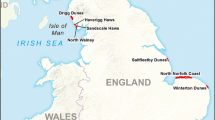Abstract
Kenfig NNR (National Nature Reserve) is a coastal sand dune system in south Wales, UK. The site is an important location for the conservation of the fen orchidLiparis loeselii, a significant proportion of the UK population is found solely on the site. Approaches to the mapping and monitoring of the habitats at Kenfig NNR using EO (Earth Observation) methods are investigated.
Typical airborne EO missions over such sites produce more than a single source of EO data; these may include various optical imaging sensors with different spectral ranges, film cameras and ranging devices to measure topography. Conservation managers are thus presented with the problem of which sources of data to use when producing a land cover map of the site of interest.
Using a data set gathered over the Kenfig NNR site, we investigate land cover mapping methods for conservation. The land cover types of interest typically cover small areas within a much larger site so they present a hard problem for the EO data and associated classification methods to solve. Land cover classifications produced from the data sets provide a set of competing hypotheses of land cover type for the site.
Methods we use to resolve this competition between the data sets include voting methods, data fusion methods and a method utilising fuzzy logic to aggregate information. This paper is intended to act as an introduction to some of the issues involved in using EO data for habitat mapping in highly heterogeneous coastal dune environments and to present some preliminary results of the performance of each method.
Similar content being viewed by others
Abbreviations
- ATM:
-
Airborne Thematic Mapper
- CASI=CCW:
-
Countryside Council for Wales; Compact Airborne Spectrographic Imager
- EO:
-
Earth Observation
- sSAC:
-
candidate Special Area for Conservation
- NNR:
-
National Nature Reserve
- OWA:
-
Ordered Weighted Average
- SSSI:
-
Site of Special Scientific Interest
References
Anon. 1949.National Parks and Access to the Countryside Act. HMSO, London, UK.
Anon. 1981.Wildlife and the Countryside Act. HMSO, London, UK.
Anon. 1990.Handbook for Phase 1 habitat survey—a technique for environmental audit. JNCC, Peterborough, UK.
Cho, S.-B. & Kim, J.H. 1995. Combining multiple neural networks by fuzzy integral for robust classification.IEEE Trans. Syst. Man Cybern. 25: 380–384.
Congalton, R.G. 1991. A review of assessing the accuracy of classifications of remotely sensed data.Remote Sens. Environ. 37: 35–46.
Congalton, R.G., Oderwald, R.G. & Mean, R.A. 1983. Assessing Landsat classification accuracy using discrete multivariate statistical techniques.Photogramm. Engin. Remote Sens. 49: 1671–1678.
Foody, G.M. 1999. The continuum of classification fuzziness in thematic mapping.Photogramm. Engin. Remote Sens. 65: 443–451.
Foody, G.M., Campbell, N.A., Trodd, N.M. & Wood, T.F. 1992. Derivation and applications of probabilistic measures of class membership from the maximum likelihood classification.Photogramm. Engin. Remote Sens. 58: 1335–1341.
Grabisch, M. 1996. The application of fuzzy integrals in multicriteria decision making.Eur. J. Operat. Res. 89: 445–456.
Lee, H.-M. & Lee-Kwang, H. 1994. Information aggregating networks based on extended Sugeno's fuzzy integral. In: Furuhashi, T. (ed.)IEEE/Nagoya University Wisepersons Workshop, pp. 56–66, Springer, Heidelberg, DE.
McGwire, K.C. 1992. Analyst variability in labelling unsupervised classifications.Photogramm. Engin. Remote Sens. 58: 1673–1677.
Rosenfield, G.H. & Fitzpatrick-Lins, K. 1986. A coefficient of agreement as a measure of thematic classification accuracy.Photogramm. Engin. Remote Sens. 52: 223–227.
Rumelhart, D.E., Hinton, G.E. & Williams, R.J. 1986. Learning internal representations by error propagation. In: Rumelhart, D.E. & McClelland, J.L. (eds.)Parallel distributed processing: Explorations of the microstructure of cognition, Ch. 8, pp. 319–362. MIT Press, Cambridge, MA, US.
Stehman, S.V. 2000. Practical implications of design-based sampling inference for thematic map accuracy assessment.Remote Sens. Environ. 72: 35–45.
Sugeno, M. 1974.Theory of fuzzy integrals and its applications. Ph.D. Thesis, Tokyo Institute of Technology, Tokyo, JP.
Sugeno, M. 1977. Fuzzy measures and fuzzy integrals: A survey. In:Fuzzy automata and decision processes, pp. 71–78. North Holland Publishing, Amsterdam, NL.
Tahani, H. & Keller, J.M. 1990. Information fusion in computer vision using the fuzzy integral.IEEE Trans. Syst. Man Cybern. 20: 733–741.
Thackrah, G.N. 2001.Habitat mapping and biodiversity monitoring using Earth Observation and GIS. Ph.D. Thesis, University of Wales, Swansea, UK.
Thackrah, G.N., Barnsley, M.J. & Pan, P. 1999. Merging land cover classifications from artificial neural networks using the Sugeno fuzzy integral. In: Barnsley, M.J. (ed.)RSS99, From data to information, pp. 71–78. RSS, Nottingham, UK.
Thackrah, G.N., Barnsley, M.J. & Pan, P. 2000. Evaluating the accuracy of merged land cover classifications made using a fuzzy integral. In: Sincak, P. (ed.),Quo vadis computational intelligence?, Ch. 4, pp. 186–191. Springer, Heidelberg, DE.
Wood, J.D. 1996.The geomorphological characterisation of Digital Elevation Models Ph.D. Thesis, University of Leicester, UK.
Yager, R.R. 1988. On Ordered Weighted Averaging aggregation operators in multicriteria decision making.IEEE Trans. Syst. Man Cybern. 18: 183–190.
Yager, R.R. 1998. Including importances in OWA aggregations using fuzzy systems modelling.IEEE Trans. Fuzzy Syst. 6: 286–294.
Author information
Authors and Affiliations
Corresponding author
Rights and permissions
About this article
Cite this article
Thackrah, G., Rhind, P., Hurford, C. et al. Using earth observation data from multiple sources to map rare habitats in a coastal conservation area. J Coast Conserv 10, 53–64 (2004). https://doi.org/10.1652/1400-0350(2004)010[0053:UEODFM]2.0.CO;2
Received:
Revised:
Accepted:
Issue Date:
DOI: https://doi.org/10.1652/1400-0350(2004)010[0053:UEODFM]2.0.CO;2




